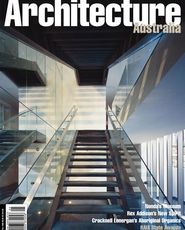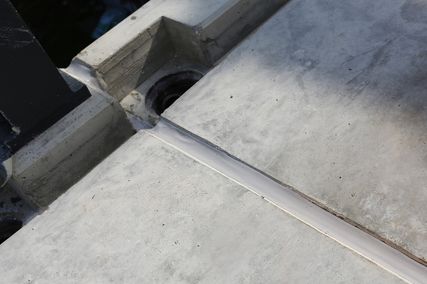 | BEYOND ARCHITECTURE: MARION
MAHONY AND WALTER BURLEY
GRIFFIN: AMERICA AUSTRALIA INDIA
Edited by Anne Watson, Powerhouse
Publishing, $40.
When forces of darkness destroyed the
Griffins’ Pyrmont incinerator in 1992,
Sydney’s Powerhouse Museum became the
custodian of a cache of key relics. At the
same time, its curators began developing an
exhibition to seriously document the couple’s
trans-continental career-with new
emphasis on the faintly acknowledged
contributions of Marion. That presentation,
now open, is well worth inspecting-as is
this associated document. Not merely a
catalogue of the artefacts, it’s a sumptuously
illustrated collection of important new essays
by top Griffin scholars. In the United States,
Paul Kruty discusses the Griffins’ developing
years in Chicago and late period in India,
while Paul Sprague denies suggestions that
Marion was the real design genius of the
pair. Although USyd Associate-Professor
Anna Rubbo avoids making that claim in her
exploration of Marion’s work and persona,
media reports on the exhibition have
emphasised history’s unfair treatment of
architecture’s first registered “lady”. Other
essays include UNSW’s James Weirick on
the Griffins’ spiritual inspirations and
mentalities; Christopher Vernon on Walter’s
landscape art; Jeffrey Turnbull on their
democratic tendencies and Anne Watson on
the furnishings. To understand the main
catalysts of 20th century Australian
architecture, allocate about six hours to
digest these essays, and go to the show TWO AMERICAN ARCHITECTS IN
INDIA: WALTER B. GRIFFIN AND
MARION M. GRIFFIN 1935-1937
By Paul Kruty and Paul E. Sprague,
School of Architecture, University of
Illinois, price on order.
America’s hottest Griffin scholars compiled
this catalogue for a 1997 exhibition, at the
University of Illinois Urbana-Champaign, of
the Griffins’ designs from Walter’s last two
years in India. This text-dense document
doesn’t look seductive (for economy, the 16
colour plates are lassooed together in one
section at the back), but it offers Griffin fans
many fascinating new revelations about the
partnership of Walter and Marion during their
final years together. Particularly interesting
are quotes from two obituaries-one by a
Muslim rajah and the other by a British
colonial-which both described Walter as
noble, selfless, unassuming and saintly;
qualities which might hint at why he
regularly argued with his first employer,
Frank Lloyd Wright.
CIVIC REALISM
By Peter G. Rowe, MIT Press, $60.
After his significant study of the ‘middle
landscape’ (suburbs) several years ago,
expatriate Australian architect Peter Rowe
(Dean of Design at Harvard), has invented
another catchy term-‘civic realism’-to
caption this personal and regrettably
pompous exploration of meaning in public space. | Meandering across immaculate
Bodoni pages in search of poetic Italian
precedents applicable to the pragmatics of
modern city planning, he seems to stumble
upon crucial ideas which are picked up and
examined but never convincingly clarified.
His key platitude is that successful public
places support the ‘everyday’ behaviour of
‘commonplace’ people-not the special
demands of elite groups. This useful point-
one which often eludes Australian and
American governments and planners-is
muddied in an elaborate analysis of the need
to establish “verisimiltude of content” and
“verisimiltude of genre”. Yet he is elsewhere
amazingly simplistic-as with his claim that
the best civic places are made “across the
divide between the state and civil society”.
That early Enlightenment duality has never
been useful in capitalist contexts-and
seems utterly anachronistic for today’s mode
of global markets and ‘economic-rationalist’
governments. Readers are advised to follow
Rowe with a bracing chaser of John Ralston
Saul’s Voltaire’s Bastards.
THE FLOORING BOOK
By Elizabeth Wilhide with photography
by Henry Bourne, Murdoch , $40.
This is one of those useful but terminal
scrapbooks that become handy when a
domestic renovation looms and the cortex
cries for optical stimulation. It’s an attractive
hardcover digest of contemporary flooring
ideas culled from international decorating
magazines and photo bureaux, including
Australian examples. Ahead of a
‘Practicalities’ section illustrating how to lay
and maintain floors, the book provides a
good selection of materials options, including
paper twine rugs, light-conducting glass
platforms, and seventies favourites cork,
rubber, slate and carpet (they’re back!). TECHNICAL MANUALS
Laboratory Design Guide, by Brian
Griffin, Architectural Press/Butterworth
Heineman, $85.
Although not a gripping topic for most
architects, this looks like a good guide for
novices suddenly thrown the challenge of
planning modern scientific research
facilities. The text is comfortably consumed,
there are many good ink drawings and the
colour photographs, of various recent case
studies, are valuable.
Colour, by Barbara Allen and Marie
Cook, TAFE Publications, $37.50.
This is an informative and comprehensive
workbook for Australian students of colour
theory, but it’s diminished by poor graphic
design, uninspiring photographs and a cover
which clashes three contradictory palettes in
one of the least appealing package designs
we’ve seen in a long time.
Soft Furnishings, by Barbara Allen and
Marie Cook, TAFE Publications, $45.
A dry workbook for technical college
students on constructing curtains, blinds
and upholstery. Not terrific.
Notices by Davina Jackson. Architext
bookshops are at Tusculum, Sydney, ph
02 9356 2022 and 41 Exhibition Street,
Melbourne, ph 03 9650 3474. |
















